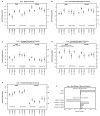Neonatal parathion exposure and interactions with a high-fat diet in adulthood: Adenylyl cyclase-mediated cell signaling in heart, liver and cerebellum
- PMID: 20074626
- PMCID: PMC2826615
- DOI: 10.1016/j.brainresbull.2010.01.003
Neonatal parathion exposure and interactions with a high-fat diet in adulthood: Adenylyl cyclase-mediated cell signaling in heart, liver and cerebellum
Abstract
Organophosphates are developmental neurotoxicants but recent evidence points to additional adverse effects on metabolism and cardiovascular function. One common mechanism is disrupted cell signaling mediated through cyclic AMP, targeting neurohumoral receptors, G-proteins and adenylyl cyclase (AC) itself. Earlier, we showed that neonatal parathion evokes later upregulation of the hepatic AC pathway in adolescence but that the effect wanes by young adulthood; nevertheless metabolic changes resembling prediabetes persist. Here, we administered parathion to neonatal rats (postnatal days 1-4, 0.1 or 0.2 mg/kg/day), straddling the threshold for cholinesterase inhibition, but we extended the studies to much later, 5 months of age. In addition, we investigated whether metabolic challenge imposed by consuming a high-fat diet for 7 weeks would exacerbate neonatal parathion's effects. Parathion alone increased the expression or function of G(i), thus reducing AC responses to fluoride. Receptors controlling AC activity were also affected: beta-adrenergic receptors (betaARs) in skeletal muscle were increased, whereas those in the heart were decreased, and the latter also showed an elevation of m(2)-muscarinic acetylcholine receptors, which inhibit AC. The high-fat diet also induced changes in AC signaling, enhancing the hepatic AC response to glucagon while impairing the cardiac response to fluoride or forskolin, and suppressing betaARs and m(2)-muscarinic receptors; the only change in the cerebellum was a decrease in betaARs. Although there were no significant interactions between neonatal parathion exposure and a high-fat diet, their convergent effects on the same signaling cascade indicate that early OP exposure, separately or combination with dietary factors, may contribute to the worldwide increase in the incidence of obesity and diabetes.
Copyright 2010 Elsevier Inc. All rights reserved.
Figures



References
-
- Abdollahi M, Donyavi M, Pournourmohammadi S, Saadat M. Hyperglycemia associated with increased hepatic glycogen phosphorylase and phosphoenolpyruvate carboxykinase in rats following subchronic exposure to malathion. Comp. Biochem. Physiol. Toxicol. Pharmacol. 2004;137:343–347. - PubMed
-
- Auman JT, Seidler FJ, Slotkin TA. Neonatal chlorpyrifos exposure targets multiple proteins governing the hepatic adenylyl cyclase signaling cascade: implications for neurotoxicity. Dev. Brain Res. 2000;121:19–27. - PubMed
-
- Casida JE, Quistad GB. Organophosphate toxicology: safety aspects of nonacetylcholinesterase secondary targets. Chem. Res. Toxicol. 2004;17:983–998. - PubMed
-
- De Peyster A, Willis WO, Molgaard CA, MacKendrick TM, Walker C. Cholinesterase and self-reported pesticide exposure among pregnant women. Arch. Environ. Health. 1993;48:348–352. - PubMed
Publication types
MeSH terms
Substances
Grants and funding
LinkOut - more resources
Full Text Sources
Medical
Miscellaneous

